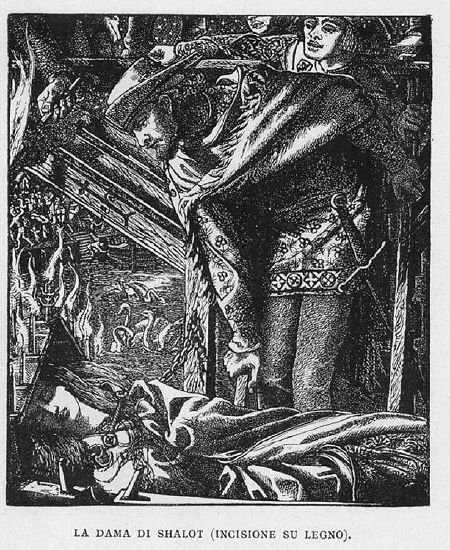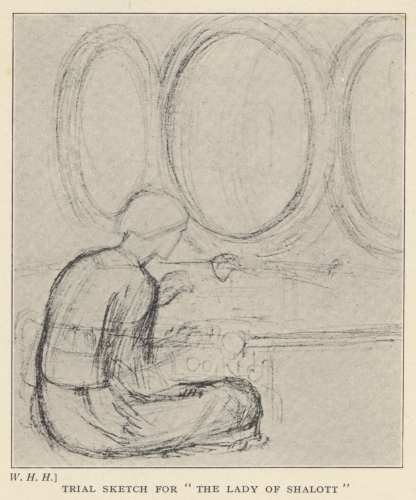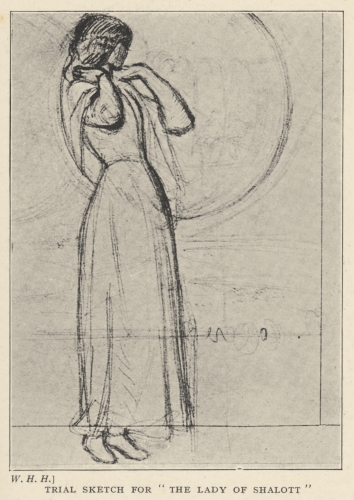The Man Behind "The Lady"
Portia Favro and Marilee Devries
1303
|
Before creating a final piece of work, most artists will create a rough sketch or outline of what their general idea is for the piece. During the Victorian Era, some artists chose to create pieces that may have been inspired by literature to create engravings. Dante Gabriel Rossetti created a sketch depicting a scene from “The Lady of Shalott”, which would eventually be made into a woodcut engraving@ Rossetti, Dante Gabriel.The Lady of Shalott (sketch). 1856-1857 . The sketch was done in pencil, pen and brown ink between 1856-57, and depicts Part IV of the poem, as the Lady is dying@ Rossetti, Dante Gabriel.The Lady of Shalott (sketch). 1856-1857 . As the visual object, this sketch gives a base for how the engraving would look, and hints at social practices during the Victorian era. The engraving of Rossetti’s image can also be seen as another visual object, especially through its depiction@Marillier, H.C., Dante Gabriel Rossetti, An Illustrated Memorial of His Art and Life, 1899. Engraving from http://www.rossettiarchive.org/zoom/sa21.m.img.html. The engraving itself was woodcut, and shows the same scene as the sketch: of Lancelot leaning and appearing to be watching over the Lady of Shalott. This can be seen as almost as a controlling or menacing action by Lancelot over the Lady, and her position beneath him is a visual of lower social status. Arguably, this could be depicting the suppression of women and enforcing their role as a lower-ranked citizen in society. |
Artist William Holman Hunt was another artist who created visuals for an illustrated book @Hunt, William Homan,Pre-Raphaelitism and the Pre-Raphaelite Brotherhood,(1914)
published by Publisher:E. P. Dutton and Company. Pages 70, 73-74by Edward Moxon of Tennyson’s work called Poems in 1857@Nelson, Elizabeth, "The Lady of Shalott", Adapted fromRossetti, Dante Gabriel.The Lady of Shalott (sketch). 1856-1857.http://www.victorianweb.org/authors/tennyson/losillus1.html
(which Rosetti also created illustrations for). Looking at the volume, which was being created during the Victorian Era and nearly 25 years since “The Lady of Shalott” was first published, the comments upon society through Tennyson’s work comes through the illustrations.@Hunt, William Homan,Pre-Raphaelitism and the Pre-Raphaelite Brotherhood,(1914)
published by Publisher:E. P. Dutton and Company. Pages 73-74
http://www.rossettiarchive.org/docs/nd467.h9.1914.2.rad.html
In Hunt’s case, his discussion about the process of creating visuals to accompany Tennyson’s words may lead one to interpret them as a comment upon society. For example, Hunt’s illustration of the Lady shows a female character slumped over and physically smaller, showing visual hierarchy. This is a technique used throughout generations of artists internationally, which depicts the most important subject in a illustration through size. However, Hunt created another sketch which shows the Lady standing, looking out the window (connecting to a moment within the poem when she is looking out over the lovers) meeting Lancelot, the departure from her island, and her movement toward death@Hunt, William Homan,Pre-Raphaelitism and the Pre-Raphaelite Brotherhood,(1914)
published by Publisher:E. P. Dutton and Company. Pages 73-74
http://www.rossettiarchive.org/docs/nd467.h9.1914.2.rad.html. Looking through the sketches and commentary of “The Lady” there is no mention of a female perspective or model for the illustrations for Poems@Hunt, William Homan,Pre-Raphaelitism and the Pre-Raphaelite Brotherhood,(1914)
published by Publisher:E. P. Dutton and Company. Pages 73-74
http://www.rossettiarchive.org/docs/nd467.h9.1914.2.rad.html.
In closer relation to Moxon’s Poems, Dante Gabriel Rossetti also contributed to creating visuals, such as the woodcut engraving that appeared at the end of the book. His sketch, discussed above, shows The Lady in a lower place of hierarchy, and shows a moment in Victorian society where women may have experienced “social death” and the notion of being trapped inside as the “Angel of the Household”.
published by Publisher:E. P. Dutton and Company. Pages 70, 73-74by Edward Moxon of Tennyson’s work called Poems in 1857@Nelson, Elizabeth, "The Lady of Shalott", Adapted fromRossetti, Dante Gabriel.The Lady of Shalott (sketch). 1856-1857.http://www.victorianweb.org/authors/tennyson/losillus1.html
(which Rosetti also created illustrations for). Looking at the volume, which was being created during the Victorian Era and nearly 25 years since “The Lady of Shalott” was first published, the comments upon society through Tennyson’s work comes through the illustrations.@Hunt, William Homan,Pre-Raphaelitism and the Pre-Raphaelite Brotherhood,(1914)
published by Publisher:E. P. Dutton and Company. Pages 73-74
http://www.rossettiarchive.org/docs/nd467.h9.1914.2.rad.html
In Hunt’s case, his discussion about the process of creating visuals to accompany Tennyson’s words may lead one to interpret them as a comment upon society. For example, Hunt’s illustration of the Lady shows a female character slumped over and physically smaller, showing visual hierarchy. This is a technique used throughout generations of artists internationally, which depicts the most important subject in a illustration through size. However, Hunt created another sketch which shows the Lady standing, looking out the window (connecting to a moment within the poem when she is looking out over the lovers) meeting Lancelot, the departure from her island, and her movement toward death@Hunt, William Homan,Pre-Raphaelitism and the Pre-Raphaelite Brotherhood,(1914)
published by Publisher:E. P. Dutton and Company. Pages 73-74
http://www.rossettiarchive.org/docs/nd467.h9.1914.2.rad.html. Looking through the sketches and commentary of “The Lady” there is no mention of a female perspective or model for the illustrations for Poems@Hunt, William Homan,Pre-Raphaelitism and the Pre-Raphaelite Brotherhood,(1914)
published by Publisher:E. P. Dutton and Company. Pages 73-74
http://www.rossettiarchive.org/docs/nd467.h9.1914.2.rad.html.
In closer relation to Moxon’s Poems, Dante Gabriel Rossetti also contributed to creating visuals, such as the woodcut engraving that appeared at the end of the book. His sketch, discussed above, shows The Lady in a lower place of hierarchy, and shows a moment in Victorian society where women may have experienced “social death” and the notion of being trapped inside as the “Angel of the Household”.




